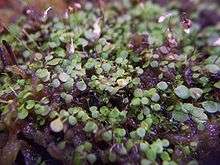Utricularia striatula
Utricularia striatula is a small carnivorous plant that belongs to the genus Utricularia. It is widespread from tropical Africa to New Guinea.[1] U. striatula grows as a lithophyte or epiphyte on wet rocks or tree trunks at altitudes from near sea level to 3,300 m (10,827 ft). It was originally described by James Edward Smith in 1819.[2]
| Utricularia striatula | |
|---|---|
 | |
| Scientific classification | |
| Kingdom: | Plantae |
| Clade: | Tracheophytes |
| Clade: | Angiosperms |
| Clade: | Eudicots |
| Clade: | Asterids |
| Order: | Lamiales |
| Family: | Lentibulariaceae |
| Genus: | Utricularia |
| Subgenus: | Utricularia subg. Bivalvaria |
| Section: | Utricularia sect. Phyllaria |
| Species: | U. striatula |
| Binomial name | |
| Utricularia striatula | |
| Synonyms | |
| |
See also
References
- "Utricularia_striatula". World Checklist of Selected Plant Families. Royal Botanic Gardens, Kew. Retrieved 2018-01-09.
- Taylor, Peter. (1989). The genus Utricularia - a taxonomic monograph. Kew Bulletin Additional Series XIV: London.
This article is issued from Wikipedia. The text is licensed under Creative Commons - Attribution - Sharealike. Additional terms may apply for the media files.